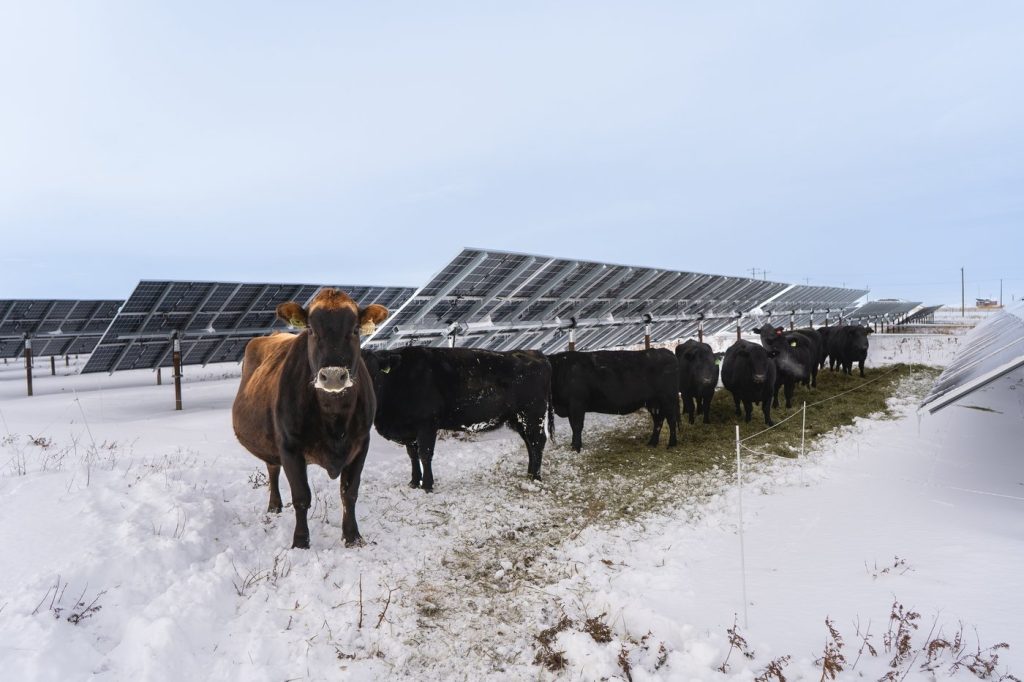Solar burgers: How agrivoltaics is marrying food production with green energy

Posted Dec 25, 2024 07:00:07 AM.
Last Updated Dec 25, 2024 07:01:09 AM.
CALGARY — Jason Bradley spent 20 years of his career as ranch manager at a 50,000-acre grazing operation in west-central Alberta, so he understands why people react with skepticism to the idea of raising a herd of cattle on a working solar farm.
“The first thing people think is, ‘You can’t put cattle on (a solar farm). They’re just going to rub on the panels and wreck them,'” Bradley said.
But as the CEO of Calgary-based Sun Cycle Farms, Bradley believes the doubters have already been proven wrong. This fall, Sun Cycle conducted a pilot project that grazed cattle inside a grid-connected solar farm in southern Alberta — something Bradley said proves that livestock production and renewable energy can successfully co-exist.
“It was not just to prove it to ourselves — I knew it could be done in an existing solar facility,” Bradley said.
“But we had to prove to the asset owner, to the insurance company, even to investors that are looking at this and show this is a part of the solution.”
Sun Cycle Farms is an agrivoltaics company, part of a rapidly expanding field that aims to combine solar energy production with agricultural activities. Across North America, solar farm owners are increasingly deploying sheep and even pigs at their sites to keep the weeds down and reduce the need for mowing around the panels.
Researchers around the world are also looking into what types of crops can be grown in and around solar panels.
Contrary to what you might expect, many crops actually perform better when shaded by a massive solar panel than they do under direct sunlight, said Joshua Pearce, a solar energy expert at Western University.
“Most crops that we have grown outdoors normally actually get a little bit too much sun,” Pearce said.
“Underneath the solar panel, or next to it, you have almost like a protected micro-environment. There’s not as much wind, you don’t have to worry about hail, it even helps to preserve the water in the soil a little more.”
Land use issues were less pressing when solar energy was in its infancy a couple of decades ago because the fledgling industry was so small.
But the rapid rollout of renewable power in recent years means the physical footprint of solar can no longer be ignored. According to the Canadian Renewable Energy Association, there are 206 major solar energy projects producing power across the country — some of which take up thousands of acres of land.
As a result of the industry’s dramatic growth, some rural residents have become frustrated with how rapidly the landscapes around them have changed, as well as the activity that takes place on the land.
“If you’re in a rural community that takes pride in farming and producing from the land, and then suddenly you have large funders that are from outside your community buying up huge tracts of land and turning it into solar parks, you can get pretty agitated and concerned about it,” Pearce said.
In Alberta, which has seen the most dramatic growth in solar energy in all of Canada in recent years, the provincial government recently introduced new regulations that bar renewable energy installations from being built on prime agricultural land unless developers can prove their projects can co-exist with livestock and crops.
“Renewable energy is a double-edged sword because we need energy generation in our province, but we also need to maintain the integrity of good agricultural land,” said Jeff Shaw, chief administrative officer for the Town of Cardston, which is currently partnering with Sun Cycle Farms on an agrivoltaics demonstration project located at the edge of the southern Alberta community.
“We (the town) would love to be associated with a solution for that.”
Success in agrivoltaics often requires flexible thinking. Goats, for example, have been tested on solar farms but were not particularly successful because of their tendency to chew on wires.
In its cattle demonstration project, Sun Cycle used electric fencing to train the cattle to stay away from the solar panels. The company is also exploring the use of solar-powered collars — which would give the cows a little ‘ping’ as a deterrent if they get too close — as well as the use of robot tractors to safely remove weeds and cut hay around the site without damaging the panels.
While more research will need to take place before the co-existence of cows and solar panels becomes commonplace, Pearce said these kinds of projects are key to ensuring the long-term sustainability of the renewable energy sector and the ongoing productivity of the agriculture sector.
“With agrivoltaics, everybody wins — the landowner, the farmers, the solar developers, the community, the electricity grid. It’s just a good idea,” he said, adding it’s only a matter of time before the grazing of cattle among renewable energy installations becomes commonplace.
“And then we’ll have solar burgers. It’ll be quite nice.”
“This report by The Canadian Press was first published Dec. 25, 2024.
Amanda Stephenson, The Canadian Press








